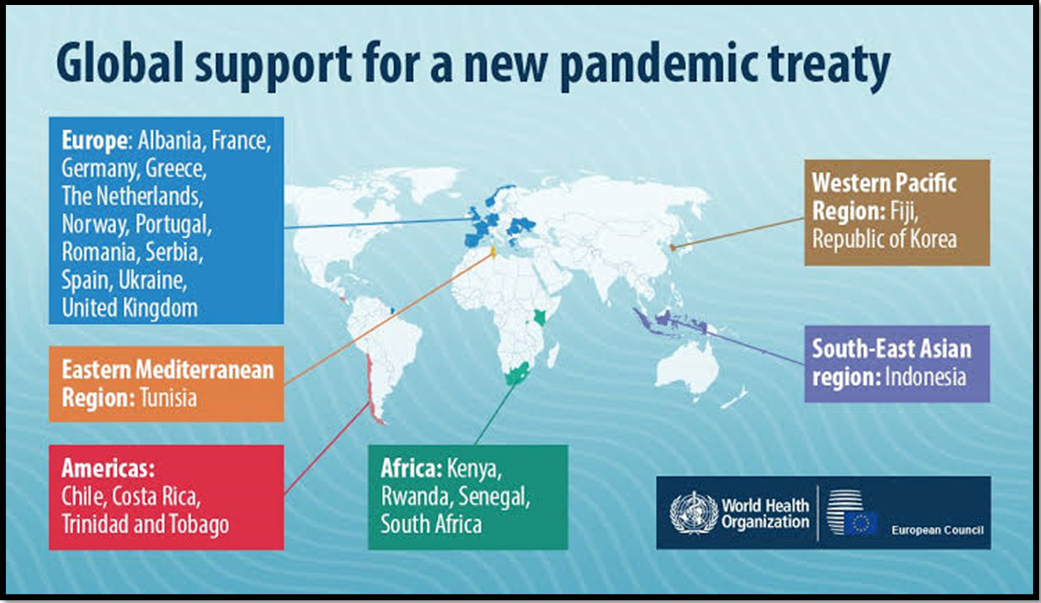THE COUNTDOWN TO A PANDEMIC TREATY
Syllabus:
- GS 2: Bilateral, Regional and Global Groupings and Agreements involving India
- GS 3 : Conservation, Environmental Pollution and Degradation
Focus:
The article highlights an unprecedented call in March 2021 by 25 heads of government and international agencies for a pandemic treaty, signaling a pivotal moment in global health governance.
Historical Call for a Pandemic Treaty
- Unprecedented Call in March 2021:
- 25 heads of government and international agencies called for a pandemic treaty.
- Signalled a pivotal moment in global health governance.
- Ninth INB Meeting:
- Final leg of negotiations for the 30-page WHO Pandemic Agreement.
- Began on March 18, marking a significant milestone.
- World Health Assembly Decision:
Source: EU
- Meeting in late May to decide the fate of the Pandemic Agreement.
- Risk of collapse due to contentious debates among member states.
- Comparative Significance:
- Most momentous time in global health since 1948.
- Highlights the urgency and importance of the proposed treaty.
Objective and Scope of the WHO Pandemic Agreement
- Addressing Systemic Failures:
- Aim to rectify failures revealed by the COVID-19 crisis.
- Strengthen global defenses against future pandemics.
- Equity as Central Theme:
- Goal of strengthening pandemic prevention, preparedness, and response with equity.
- Addressing searing inequity witnessed during the COVID-19 pandemic.
- Key Focus Areas:
- Pathogen surveillance, health-care workforce capacity, supply chain, and logistics.
- Technology transfer to support vaccine, diagnostic test, and treatment production.
- Additional Commitments:
- Better management of antimicrobial resistance.
- Strengthening health systems, sanitation, and progress towards universal health coverage.
- Emphasis on Equitable Access:
- Throughout the text, the theme of equitable access to medical products is highlighted.
- Provisions on principles, preparedness, production, technology transfer, and supply and procurement reflect this emphasis.
| World Health Organization (WHO)
· Founded in 1948 as the UN’s specialized health agency. · Headquarters located in Geneva, Switzerland. · Comprises 194 Member States, 150 country offices, and six regional offices. · Operates as an inter-governmental organization, collaborating with member states, primarily through Ministries of Health. · Leads global health initiatives, sets health norms, provides technical support, and monitors health trends. · World Health Day celebrated annually on April 7, marking its inception. Objectives of WHO · Serve as the directing and coordinating authority for international health work. · Foster collaboration with UN agencies, governmental health bodies, and professional groups. · Provide assistance to governments in enhancing health services. · Promote cooperation among scientific and professional entities advancing health. Governance Structure · World Health Assembly (WHA): WHO’s main decision-making body attended by all member states’ delegations. · Annual sessions held at WHO headquarters in Geneva, Switzerland. · Focuses on specific health agendas set by the Executive Board. · 2022 marked the first in-person assembly since the start of the Covid-19 pandemic. Functions of the Health Assembly · Determines WHO’s organizational policies. · Oversees financial policies and approves the budget. · Reports to the UN’s Economic and Social Council as per the agreement between WHO and the UN. Membership Criteria · UN Member States eligible for WHO membership. · Territories or groups not responsible for international relations can be Associate Members upon Health Assembly approval. |
Contentious Issues and Concerns
- Pathogen Sharing and Benefit-Sharing:
- Developing countries hesitant to share pathogen information without clear benefits.
- Proposed WHO Pathogen Access and Benefit-Sharing (PABS) System to address concerns.
- Requires data sharing in exchange for free or discounted medical products.
- Enforcement and Accountability:
- Absence of robust enforcement mechanisms and accountability threatens Agreement’s effectiveness.
- Challenges include coordination for pandemic countermeasure stockpiles, international medical response teams, and data sharing.
- Intellectual Property (IP) Waivers:
- Controversial issue requiring firms with public financing to waive or reduce IP royalties.
- A major point of contention between developed and developing countries.
- Conference of Parties (COP) Establishment:
- Proposed to oversee Agreement implementation.
- Indicates potential classification as a classic international treaty under Article 19 of the WHO Constitution.
- Negotiation Disparities:
- Developing countries largely support the revised text, while developed countries criticize it.
- Disagreements on financing, obligations, and responsibilities persist.
Next Steps and Challenges Ahead
- Geneva Negotiation Conclusion:
- Current round of negotiations aims for a consensus decision by the World Health Assembly.
- Risk of a watered-down Agreement due to the imperative of consensus.
- Potential Outcomes:
- Successful Agreement would be a critical step towards rebuilding trust and coordination between nations.
- Failure to reach Agreement would be a serious blow, acknowledging the necessity of international collaboration.
- UNFCCC Summit Model:
- Proposals for a decision-making body, comprising the COP along with a secretariat.
- Uncertainty remains regarding the consensus on this structure.
- Enforcement Challenges:
- Existing International Health Regulations are legally binding but failed during the COVID-19 pandemic.
- Need for robust enforcement mechanisms to ensure effectiveness and accountability.
- Intellectual Property (IP) Challenges:
- Thorny issue of firms receiving public financing being required to waive or reduce their IP royalties.
- Represents a significant barrier to achieving global equity in vaccine and treatment access.
Way Forward:
- Strengthen Equity Measures: Enhance the WHO PABS System for equitable pathogen and benefit sharing.
- Implement Strong Enforcement: Introduce robust accountability frameworks for Agreement compliance.
- Resolve IP Issues: Address intellectual property challenges through balanced solutions.
- Encourage Global Collaboration: Foster international cooperation to share best practices and resources.
- Invest in Health Systems: Prioritize investments for health system strengthening and universal coverage.
- Engage All Stakeholders: Foster inclusive dialogue with governments, industry, and civil society.
- Monitor Progress: Establish a monitoring framework to track and adapt to progress and challenges.
- Ensure Transparency: Promote transparency in negotiations and decision-making processes.
Conclusion
The WHO Pandemic Agreement represents a crucial initiative to address the systemic failures exposed by the COVID-19 crisis and strengthen global health governance. As negotiations reach a critical stage, the challenges of equity, enforcement, and intellectual property rights continue to be major sticking points. Achieving a consensus decision by the World Health Assembly in May is essential to establish a robust and effective global framework for pandemic prevention, preparedness, and response.
Source:
https://www.thehindu.com/opinion/lead/the-countdown-to-a-pandemic-treaty/article68003170.ece/amp/
Mains Practice Question:
Discuss the significance and challenges associated with the proposed WHO Pandemic Agreement, highlighting its potential implications for global health governance.





